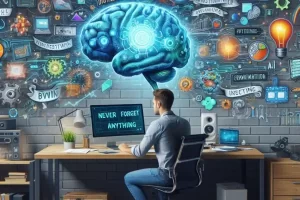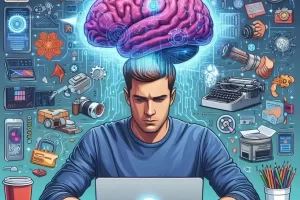Managing information is no longer just about saving it. In 2025, the real challenge is organizing it so you can find, use, and build on it — and that’s where artificial intelligence becomes your greatest ally. A second brain powered by AI transforms scattered notes, endless tasks, and disconnected ideas into a living system that thinks with you.
In this article, you’ll learn how to use AI to structure your second brain so that everything you capture — from quick ideas to long-term plans — becomes useful, retrievable, and connected. Whether you’re a student, entrepreneur, or creative, this method will help you stay mentally clear and highly productive.
Why Organizing Manually Doesn’t Work Anymore
You’ve probably tried:
- Color-coded folders
- Notebooks and apps
- Long to-do lists
- Mind maps
But over time, things still get messy. You forget what you saved. You can’t find what matters. Your system becomes another source of stress.
That’s because manual systems rely on:
- Constant maintenance
- Perfect memory
- Static categories that don’t scale
AI solves this by:
- Auto-tagging and categorizing notes and tasks
- Linking related ideas you didn’t realize were connected
- Responding to natural language searches instead of rigid labels
Centralize Everything in One System
Before organizing, you need one central hub — a home for all your content.
Use one of these tools:
- Notion (customizable databases + AI integration)
- Obsidian (markdown-based, supports AI plugins and backlinking)
- Tana or Mem.ai (AI-native knowledge managers)
Your second brain needs to hold:
- Notes and research
- Tasks and project plans
- Quick ideas
- Reference materials
Make sure you can connect and search across them all.
Let AI Handle the Initial Organization
Instead of manually sorting every note or idea, use AI tools to speed up the process.
With Notion AI or ChatGPT:
- Paste a block of text and ask: “What are the main categories in this content?”
“Summarize and tag this note with 3 keywords.”
With Obsidian + AI plugins:
- Use commands to auto-link your note to related content
- Generate tags or folder suggestions
- Ask questions about your vault like: “Which notes relate to this new project?”
You’re no longer the only one maintaining your system — AI becomes your co-pilot.
Create Smart Categories
Traditional categories (like “Work” or “Personal”) are useful but limiting. AI helps you build dynamic, multi-dimensional categories.
For example:
- A task can be tagged by context (home, travel, deep work)
- A note can be grouped by topic (productivity, design, writing) and project
- A quote can be stored in Resources but linked to your Values folder
Ask ChatGPT:
“Organize this list of notes into categories based on themes.”
“What project is this idea most aligned with?”
This creates a flexible system that adjusts as you grow.
Make Your Tasks Smarter with AI
Don’t just write down tasks — make them actionable and contextualized using AI.
Here’s how:
- After writing a meeting summary, ask: “Extract all actionable items from this note.”
- When journaling, ask: “Convert these ideas into task suggestions.”
AI also helps with task prioritization:
- “Which of these 10 tasks are urgent and important?”
- “Sort these by deadline and energy level required.”
By turning raw input into structured output, you reduce mental fatigue and boost focus.
Create AI-Powered Dashboards
In Notion, Obsidian, or Tana, create views that summarize your system dynamically.
For example:
- A Today View that shows urgent tasks + new notes
- A Project Tracker with linked research + meeting summaries
- A Review Page that lists content added in the last 7 days
You can even ask ChatGPT:
“Summarize all new content from this week.”
“What patterns do you see in my recent tasks?”
These dashboards adapt as your input grows, keeping your brain decluttered.
Link Ideas Automatically
Your second brain becomes exponentially more valuable when ideas are linked.
AI can:
- Suggest connections between related notes
- Cluster similar concepts (like all notes on “focus”)
- Map out knowledge graphs or themes in your thinking
Try this with Obsidian or Ask ChatGPT:
“What other notes relate to this one about motivation?”
“Group these 20 quotes by topic.”
This is where your second brain starts to think for itself.
Use Natural Language to Retrieve Anything
No more digging through folders. AI understands natural queries like:
- “What did I write about creativity last month?”
- “Show all tasks related to my online course.”
- “Summarize my best ideas from this year.”
This turns your second brain into a searchable knowledge assistant — not just a storage box.
Bonus: Automate Your Capture Workflow
Use tools like:
- Readwise to auto-save highlights
- Otter.ai to transcribe voice notes and meetings
- Zapier or Make.com to connect Gmail, Notion, and Google Drive
- Tana to auto-tag new notes with time and topic
AI ensures that everything gets where it needs to be without manual effort.
Real-Life Example: The Creative Entrepreneur
Imagine you’re launching a digital course. You use your second brain to:
- Save article research in Notion
- Record brainstorming voice notes on the go
- Let ChatGPT convert ideas into structured outlines
- Link market research with course modules
- Auto-generate task lists from your launch plan
When it’s time to act, your second brain delivers everything you need — organized, current, and connected.
Final Thoughts: Organize Once, Access Forever
The power of AI in your second brain is not just about storage — it’s about intelligent structure. You don’t need to spend hours tagging and sorting. Instead, let AI organize your ideas, tasks, and notes for you — and retrieve them the moment they’re needed.
By working with your second brain consistently, you’ll never feel disorganized or mentally overloaded again. You’ll always know where your best ideas are, and more importantly — how to use them.




